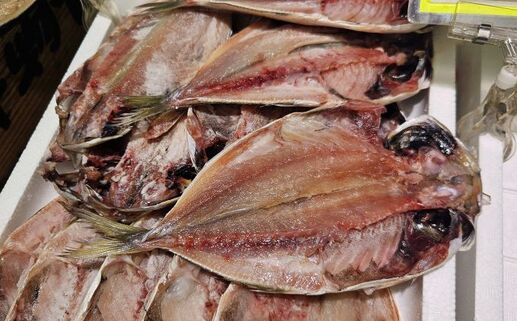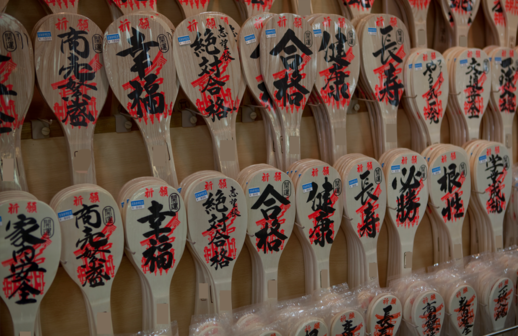2024.08.08
伝検通信(メルマガ)週刊メールマガジン「伝検通信」 第19号
週刊メールマガジン「伝検通信」第19号をお届けします。
今号のトップ記事は、食文化の話題です。地元産の魚に加えて、干物の原料に輸入魚が使われ始めているというリポートです。
「クイズで肩慣らし」は前回クイズの答え・解説と、金工・木漆工分野からの出題です。
メルマガ登録した方の中から、抽選で100人に公式テキストをプレゼントするキャンペーンも今月末まで引き続き実施中です! ぜひお近くの方にメルマガ登録をご案内ください。
伝検公式テキスト
https://bookpub.jiji.com/book/
目次
・ アジの開きは韓国産、ホッケは米国産―干物の原料に輸入魚浸透
・ 「クイズで肩慣らし」第19回(金工・木漆工)=「しゃもじ」
・ 伝検協会だより
アジの開きは韓国産、ホッケは米国産―干物の原料に輸入魚浸透
時事通信水産部長 川本大吾

アジの開き。長崎県産などのほか、韓国産を中心に外国産の原料を使って生産されることも多い。
2024年5月30日、東京都中央区の築地場外市場【時事通信社】
日本の伝統食とも言える魚の干物に、外国産の原料がじわり浸透している。製造するのは国内各地の水産加工業者だが、かつて地元でたくさん取れていた魚の水揚げが少なく、原料を確保できなくなっており、輸入魚を使う機会が増えている。
◇韓国産など輸入原料が7割
干物の名産地、神奈川県小田原市の加工業者「山安」では、古くからアジの開きを作ってきた。しかし、近場の漁港でアジを調達できなくなったため、「今は韓国産を中心に、北欧産などを含めて輸入原料が7割近くを占めるようになった」という。
静岡県の沼津市でも、輸入原料への依存度は高い。同市の加工業者によると、「地元で取れるアジはごくわずか。良質のアジをコンスタントに仕入れることはできない」という。国産の干物に向く原料を求めて、遠く長崎県などの漁港で水揚げされたアジを扱っているが、それでも十分な原料を確保できないため、この業者は「オランダやアイルランド産のほか、近年は韓国産を仕入れるケースが多い」と話す。
◇文化干しはノルウェー産のサバ
干しサバも外国産が主流となっている。サバの主産地である千葉県銚子市の水産加工業者「丸安」によると、乾燥機を使った「文化干し」の原料は「銚子港の水揚げが不安定なため、かなり前からノルウェー産を使っている」と話す。同社では、十数年以上前に銚子に揚がったサバを使ったことがあるが、加工に向く質と量が賄えずに継続的な仕入れはできなかった。「国内の他産地のサバも探したが見つからず、ノルウェー産のサバで、ずっと文化干しを作り続けている」という。
急激な円安により、仕入れ値は高くなっている。それでも、丸安は「十分な量が確保できることと、脂の乗りが良いことなど、ノルウェー産のサバにはいい干物を作るのに必要な条件がそろっている」と説明する。高品質のサバの干物を安定的に生産するには、今や国産の原料では賄えないようだ。
◇人気急上昇、米国産のシマホッケ
首都圏の台所、東京・豊洲市場(江東区)の加工品専門卸、丸千千代田水産によると、アジやサバのほか、ホッケの開き干しも外国産が目立つという。ホッケはかつて国産のマホッケが中心で、米国産のシマホッケは「水っぽくて不人気だった時期があった」という。ところが、同社は「最近は、焼いて食べるときに身離れが良くて食べやすく、脂が乗っておいしいと人気が上がり、居酒屋を中心に料理店からの注文が絶えない」と明かす。従って今ではホッケと言えば、マホッケではなく、シマホッケがメジャーになっている。
このほか、同社によると「干したシシャモは国産原料が少なく、ノルウェーやアイスランド産が使われている。ハタハタやカマスは国産が少ないものの、外国産の代替原料がなくて品薄気味」となっている。
◇輸入原料で伝統の味を継承
干物原料に輸入魚を使うことが増える一方、カタクチイワシなどを使った目刺しや煮干し、シラス干し、ムロアジなどを使った「くさや」といった干物については、十分な国産原料があることなどから、輸入魚を使う必要もないようだ。
水産加工物には製造者(加工業者)の所在地のほか、原料原産地の表示が義務付けられており、干物などを買う際、輸入魚を使った干物などの情報もラベルなどで確認できる。「小田原加工」「銚子加工」などと表示されていても、原料が外国産であるケースは今後も増えそうだ。
円安に加え、世界的に魚需要が高まっているため、日本も簡単に安く魚を輸入できる環境ではなくなっている。各地の加工業者は、かつては地元の魚を使った保存食として干物を生産してきたが、状況は大きく変化した。輸入魚をうまく活用しながら、自慢の干物を作ることで伝統的な製法を守り続けている。
▼時事ドットコムニュース 連載 「大漁! 水産部長の魚トピックス」より
「クイズで肩慣らし」第19回(金工・木漆工)=「しゃもじ」
~伝検公式テキスト(9月20日先行発売予定)のジャンルごとに出題します~

名物のしゃもじ 写真提供:時事通信フォト
第19回
問題:高校野球の夏の甲子園大会が始まりました。応援スタンドでは、「必勝」と書かれた大きなしゃもじを掲げて応援する高校生の姿もよく見かけます。このしゃもじ(木製)の発祥の地といわれ、生産量が日本一の都道府県はどこでしょう。
【前回の答えと解説】
問題:手持ち花火の代表格である線香花火。現在は、和紙で火薬を包んだものが一般的ですが、江戸時代に、ある細長いものの先に火薬をつけたものが始まりといわれています。その細長いものは何でしょう。
答え:わら
解説:線香花火は、細いわらの先に火薬を付けた棒状の花火が始まりで、江戸時代に米どころでわらが入手しやすかった関西地方で生まれました。香炉や火鉢に立てて楽しむ姿が線香に似ていることから、名前が付いたといわれています。その後伝わった関東地方では、紙すきが盛んだったこともあり、わらの代わりに和紙を使うようになり、細長くカラフルな和紙で火薬を包んだものが流行しました。
伝検協会だより
8月2日から3日間、東京・丸の内の東京国際フォーラムで開かれた「ものづくり・匠の技の祭典2024」(主催・東京都)を見学しました。日本の衣食住に携わる職人たちの伝統的な技の実演や体験プログラムもあり、外国人を含め多くの来場者でにぎわっていました。各展示ブースには江戸切子や東京洋傘など東京の伝統工芸品に交じり、能登半島地震からの復興を応援する北陸工芸コーナーや全国各地の産品も。1964年東京五輪の柔道畳にも使われた畳表の材料で、大分・国東半島の名産「くにさき七島藺(しちとうい)表」は生産農家が数軒しか残っていないそうで、こうした地域の貴重な財産を伝えていくことも伝検の役目だと思いました。
編集後記
伝検通信第19号はいかがでしたか。毎号「暑い」「暑い」
カテゴリー: 伝検通信(メルマガ)





